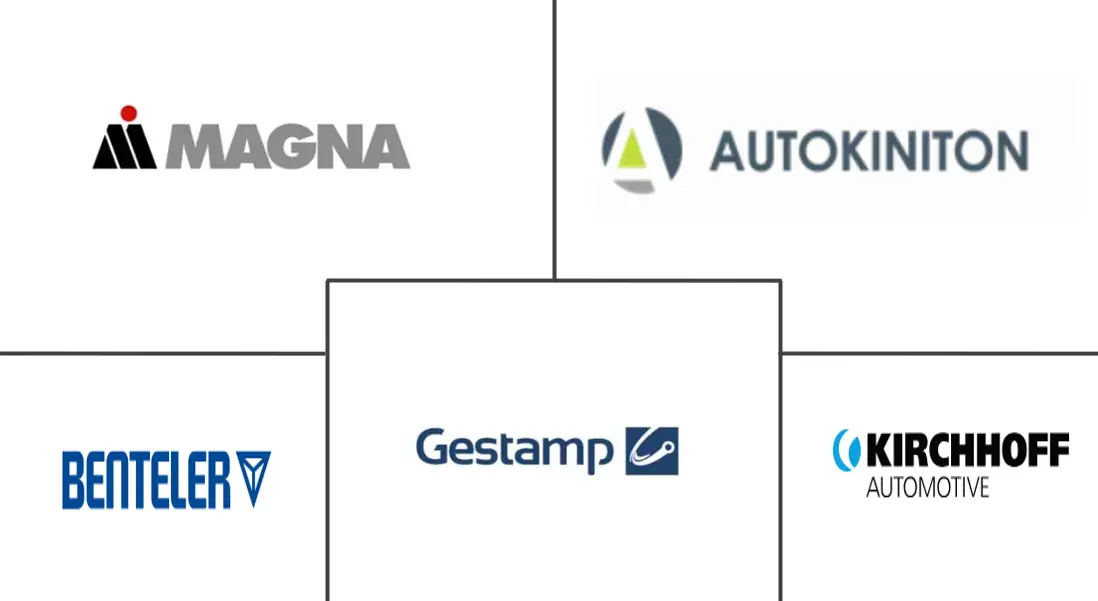Automotive Body-in-White Market Size and Share
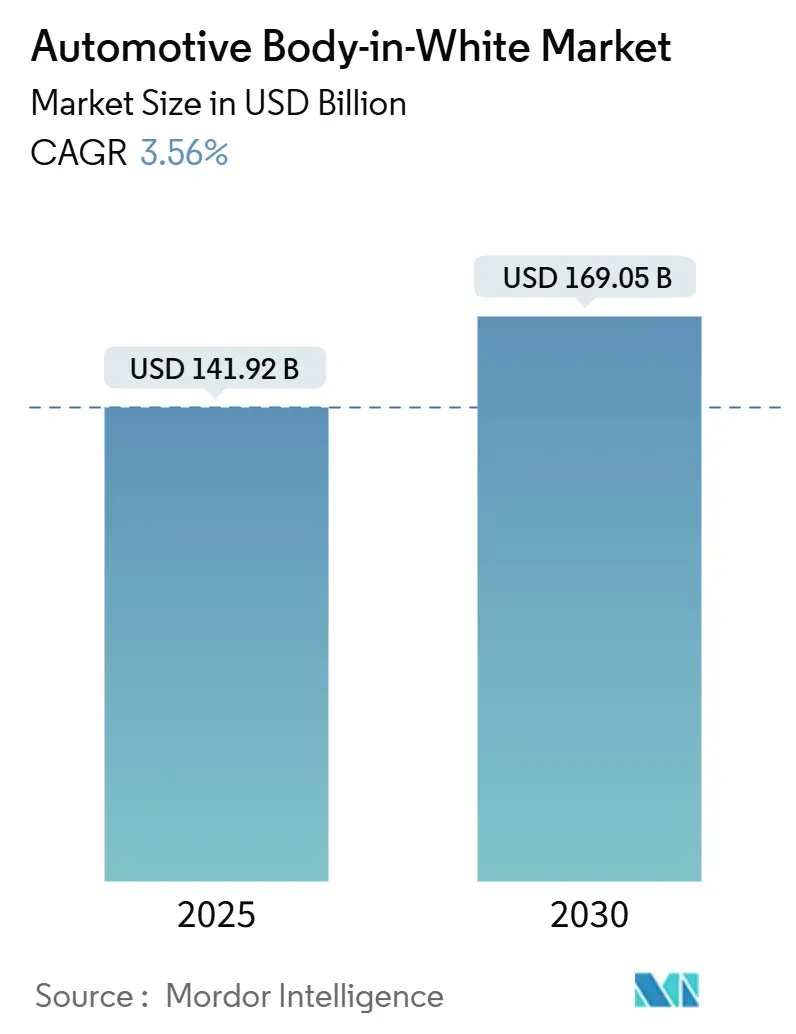
Automotive Body-in-White Market Analysis by Mordor Intelligence
The automotive body-in-white market size reached USD 141.92 billion in 2025 and is forecast to expand at a 3.56% CAGR to USD 169.05 billion by 2030. Momentum stems from regulatory pressure for lighter vehicles, rapid electrification, and the spread of giga-casting that cuts part count while boosting torsional rigidity. Automakers favor third-generation advanced high-strength steel for cost-effective weight reduction, even as aluminum, composite, and magnesium solutions gain ground. Tier-1 suppliers are responding with integrated multi-material offerings and localized production footprints that shorten supply chains and align with carbon-border policies. Meanwhile, Chinese OEMs’ pioneering of structural battery packs and giga-castings is reshaping global competitive dynamics, forcing incumbents to accelerate capital spending on next-generation body shops.
Key Report Takeaways
- By vehicle class, passenger cars captured 68.21% of the automotive body-in-white market size in 2024, yet commercial vehicles are expected to lead growth with a 4.51% CAGR through 2030.
- By propulsion, internal-combustion engines accounted for 63.38% of the automotive body-in-white market share in 2024, whereas electric vehicles are set to post an 11.12% CAGR up to 2030.
- By material type, steel commanded 63.23% of the automotive body-in-white market size in 2024; aluminum is forecast to register the fastest 6.19% CAGR during 2025-2030.
- By material joining technique, resistance spot welding retained 57.82% of the automotive body-in-white market share in 2024, while adhesive and hybrid bonding solutions are advancing at a 3.83% CAGR over 2025-2030.
- By geography, Asia-Pacific held 45.92% of the automotive body-in-white market share in 2024, while the region is projected to expand at a 4.78% CAGR through 2030.
Global Automotive Body-in-White Market Trends and Insights
Drivers Impact Analysis
| Driver | (~) % Impact on CAGR Forecast | Geographic Relevance | Impact Timeline |
|---|---|---|---|
| Growing Demand for Lightweight Vehicles | +1.2% | Global, with early adoption in Europe and North America | Medium term (2-4 years) |
| Rapid Scaling of EV Production Platforms | +1.1% | China, Europe, North America core; expanding to ASEAN | Short term (≤ 2 years) |
| Stringent Global CO₂ and Fuel-Economy Regulations | +0.9% | Europe, North America, China leading; spillover to emerging markets | Long term (≥ 4 years) |
| Advances In High-Strength Steel and Aluminum Alloys | +0.8% | Global, with R&D concentration in Germany, Japan, South Korea | Medium term (2-4 years) |
| Adoption of Giga-Cast Structures by Chinese EV OEMs | +0.7% | China leading, spreading to global EV manufacturers | Short term (≤ 2 years) |
| Greenfield ASEAN EV Plants Boosting Local BIW Capacity | +0.6% | ASEAN core, serving regional and export markets | Medium term (2-4 years) |
| Source: Mordor Intelligence | |||
Growing Demand for Lightweight Vehicles
As global markets tighten regulatory standards, the automotive industry is increasingly turning to lightweighting. Automakers are now embracing advanced materials and innovative design strategies to shed vehicle weight, all while upholding safety and performance standards. Next-generation high-strength steels are at the forefront, delivering notable weight reductions without sacrificing structural integrity or crash safety. Concurrently, as electric vehicle adoption surges, there's a heightened emphasis on lighter body structures; even slight weight cuts can lead to substantial improvements in driving range.
Though aluminum space frames have gained traction in premium segments, their elevated production costs hinder broader acceptance in the mass market. Consequently, manufacturers are meticulously weighing performance, cost, and manufacturability in their material selections.
Rapid Scaling of EV Production Platforms
Dedicated EV platforms slash part counts and enable structural battery packs that double as load paths. Tesla’s Austin plant reports a 30-40% component reduction after shifting to integrated front and rear giga-castings[1]Tesla Inc., “2025 Impact Report,” Tesla, tesla.com. BYD and NIO employ cell-to-pack architecture requiring new bonding and thermal-barrier solutions. The demand for enhanced electrical isolation surges as premium electric vehicles embrace high-voltage architectures, leading to a growing reliance on composite inserts in structural components. The heft of sizable battery packs amplifies the necessity for ultra-strong materials and refined structural designs. In response, automakers are turning to advanced steels and employing topology optimization to harmonize safety, performance, and efficiency in their next-gen vehicle platforms.
Stringent Global CO₂ and Fuel-Economy Regulations
EU Fit for 55 targets full zero-emission new-car sales by 2035, embedding weight reduction into program budgets. China’s dual-credit scheme incentivizes lightweighting to unlock favorable NEV scores[2]China Association of Automobile Manufacturers, “NEV Monthly Data,” CAAM, caam.org.cn. United States CAFE rules seek 40.4 mpg fleet averages in 2026, pushing multi-material designs once limited to luxury segments. Vehicle developers are increasingly feeling the pinch of compliance costs, which consume a significant chunk of their program budgets. Many are optimizing the body-in-white structure as a savvy, cost-effective strategy to navigate regulatory demands. Meanwhile, introducing carbon border adjustment mechanisms (CBAM) will reshape material sourcing. By penalizing imports of carbon-heavy steel, CBAM is nudging the industry towards greener, low-emission feedstocks. Such shifts underscore the importance of lightweighting and material efficiency in automotive design and procurement.
Greenfield ASEAN EV Plants Boosting Local BIW Capacity
To lure electric vehicle (EV) assemblers, Thailand, Indonesia, and Vietnam are rolling out extended tax holidays. These incentives aim to position the countries as competitive hubs for EV manufacturing in the region. The newly established plants boast modular body shops, tailored for versatile multi-material lines. These advanced facilities are designed to accommodate evolving manufacturing needs, ensuring a steady demand for adhesives, laser welding, and high-strength steels in the future. Additionally, the focus on modularity and flexibility highlights the region's commitment to fostering innovation and meeting the growing global demand for EVs.
Restraints Impact Analysis
| Restraint | (~) % Impact on CAGR Forecast | Geographic Relevance | Impact Timeline |
|---|---|---|---|
| High Cost of Advanced BIW Materials | -0.8% | Global, most acute in price-sensitive emerging markets | Short term (≤ 2 years) |
| Complex Joining and Repair of Multi-Material Structures | -0.6% | Developed markets with established service networks | Medium term (2-4 years) |
| Scarcity of Low-Carbon Steel/Aluminum Supply | -0.5% | EU and North America leading green material adoption | Long term (≥ 4 years) |
| Insurance and Repair-Cost Risks for Giga-Cast Bodies | -0.4% | Markets with advanced EV adoption and giga-casting | Short term (≤ 2 years) |
| Source: Mordor Intelligence | |||
High Cost of Advanced BIW Materials
Lightweight materials are pivotal to automotive innovation, yet their adoption hinges on a web of cost, infrastructure, and supply chain dynamics. Aluminum, celebrated for its weight-saving advantages, commands a notable premium over conventional steel. This price disparity renders aluminum more suited for premium vehicle segments, sidelining it from mass-market applications. Meanwhile, carbon fiber-reinforced plastics (CFRP) boast an outstanding strength-to-weight ratio, yet their high material and processing costs restrict their use predominantly to ultra-luxury vehicles.
Moreover, while metals benefit from established recycling infrastructures, composites lag significantly, inflating ownership costs and curtailing the potential for a circular economy. Aluminum is a prime example. The unpredictability of raw material prices further muddies sourcing strategies, posing challenges for manufacturers' long-term planning.
Complex Joining and Repair of Multi-Material Structures
Immaculate surface preparation and oven curing are essential for adhesive-bonded joints, leading to heightened capital expenditure and risks associated with takt time. These processes ensure the durability and reliability of the joints, which are critical in various applications. To avert galvanic attacks, aluminum-steel interfaces require isolation layers; overlooking these process steps can lead to latent warranty exposures, potentially impacting long-term performance[3]Gestamp Automoción, “Multi-Material Joining Guidelines,” Gestamp, gestamp.com. In collision repairs, replacing entire sections can elevate claim values by as much as 60%, significantly increasing repair costs for insurers and customers. Diverse proprietary systems necessitate extended training hours and a broader parts inventory for body shops, adding complexity to operations and rising operational expenses.
Segment Analysis
By Vehicle Type: Commercial Vehicles Drive Structural Innovation
Passenger cars represented 68.21% of the automotive body-in-white market size in 2024, whereas commercial vehicles are forecast to compound at 4.51% through 2030. Fleet operators prioritize lifetime operating savings, accepting the material premiums of aluminum space frames that cut mass and extend electric range. Electric vans carrying 100 kWh packs need 20-30% extra reinforcement, spawning demand for ultra-high-strength steel cross-members. Over the forecast, modular ladder-frame concepts will let truck OEMs mix cargo boxes, cabins, and fuel-cell mounts on one chassis, rewarding BIW suppliers that design standardized joining flanges.
Longer product cycles in commercial platforms—up to 10 years—provide volume stability for capital-intensive hot-stamping lines. Regulatory layers, such as the EU’s General Safety Regulation mandating driver-assistance sensors, push BIW designs to embed protected electronics cavities. The 2027 U.S. Phase 2 greenhouse-gas rules for heavy trucks will further widen demand for lightweight beams and cross-members, supporting steady growth in the automotive body-in-white market.
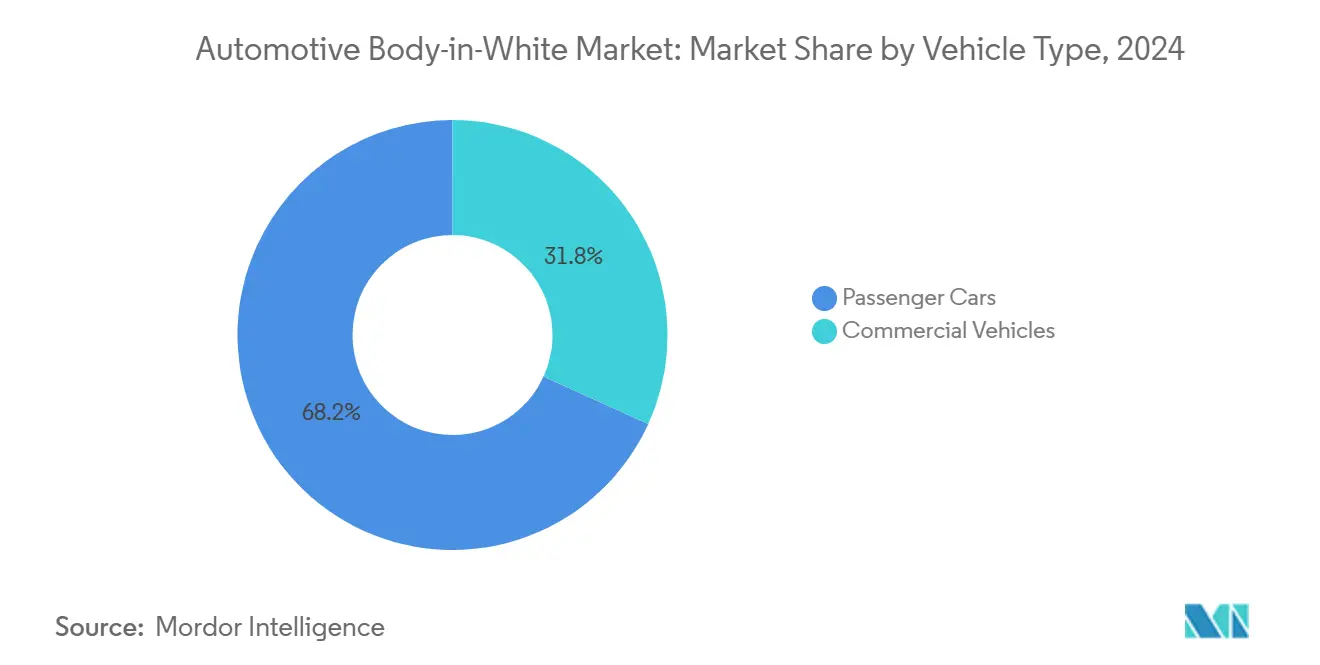
By Propulsion Type: Electric Vehicles Reshape Structural Requirements
Internal combustion engines hold a 63.38% share of the automotive body-in-white market 2024. Electric cars and trucks are rising quickly with an 11.12% CAGR through 2030. Structural battery packs eliminate separate floor pans and raise torsional stiffness by 15-20%, letting automakers delete cross rails and simplify crash-load paths. The shift to 800 V electrics ups insulation mandates, steering engineers toward composite or coated aluminum enclosures. Internal-combustion models still dominate unit volumes, preserving baseline demand for hydro-formed steel side sills optimized for crash energy absorption. Over 2025-2030, dual body architectures will coexist, compelling suppliers to maintain parallel welding and bonding competencies in the automotive body-in-white market.
Range anxiety also sustains lightweighting budgets because each kilogram trimmed from the body returns 2-3 km of driving distance. Finally, EU battery regulations require design-for-disassembly, so OEMs are replacing welded brackets with bolt-on or rivet systems that enable pack removal without structural damage.
By Material Type: Aluminum Gains Despite Steel Dominance
Steel commanded 63.23% of the automotive body-in-white market share in 2024, bolstered by low cost and mature supply chains. Yet aluminum is set to outpace steel with a 6.19% CAGR as producers roll out 7000-series sheets that hit steel-like strength at a 40% weight saving. Third-generation AHSS still expands, reaching >1,500 MPa tensile strength and supporting 25-30% gauge reductions on roof rails. Composite and magnesium content will inch upward but remain niche until recycling and cost hurdles fall.
Europe’s CBAM favors low-carbon metals, advantaging Nordic aluminum smelters powered by hydroelectricity. Regional discrepancies in scrap collection impede uniform adoption; Europe already recycles 95% of automotive aluminum, while emerging markets hover near 70%. Over time, supply security and decarbonization pressure make aluminum the principal challenger to steel in the automotive body-in-white market.
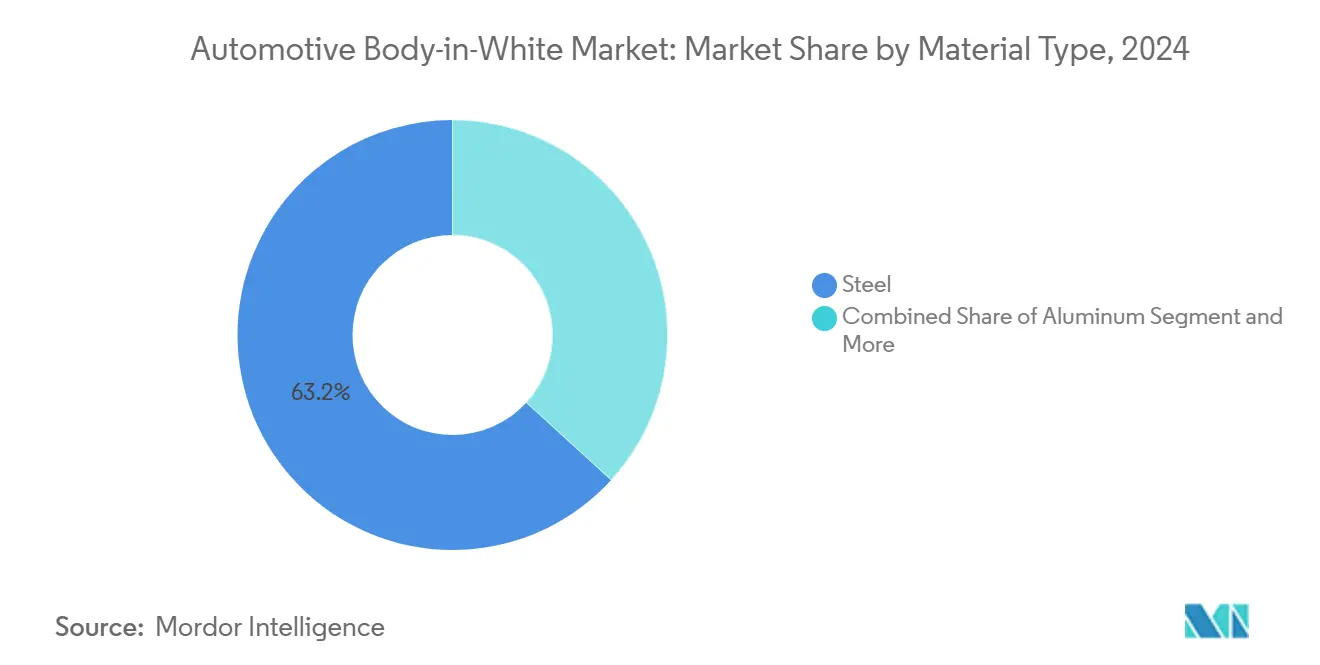
Note: Segment shares of all individual segments available upon report purchase
By Material Joining Technique: Adhesives Challenge Welding Dominance
Resistance spot welding still held 57.82% of the automotive body-in-white market share in 2024, underpinned by global line saturation and standardized electrode tooling. Adhesive and hybrid bonding will post a 3.83% CAGR to 2030, propelled by multi-material bodies where weld nuggets risk brittle failures. Structural adhesives excel at load distribution and electrical insulation, vital for 800 V EV architectures. Laser welding adoption picks up in premium segments for its narrow heat-affected zones that protect thin-gauge aluminum. Friction stir welding enables hermetic battery enclosures, and self-piercing rivets satisfy circular-economy policies that mandate reversibility. Line operators now earn certification across up to six joining processes, a sharp rise from two a decade ago, underscoring skills complexity within the automotive body-in-white market.
Geography Analysis
Asia-Pacific commanded 45.92% of the automotive body-in-white market share in 2024 and is tracking a 4.78% CAGR to 2030. China drives volume via New Energy Vehicle quotas, while BYD and NIO champion structural battery packs that reshape load-path design. Japanese steelmakers advance 1,500 MPa AHSS, supplying domestic and ASEAN factories. South Korea clusters BIW, battery, and module suppliers, accelerating vertical integration.
Europe retains technological leadership in multi-material joining and decarbonized production. German toolmakers ship hot-stamping lines with localized quench zones. Nordic aluminum producers are now supplying feedstock with a markedly reduced carbon footprint, outpacing traditional coal-based smelters in the automotive manufacturing sector. With the introduction of carbon border adjustment mechanisms (CBAM) imposing taxes on high-emission imports, the advantages of these Nordic producers are becoming more sharply focused. Automakers are pivoting towards low-carbon materials and body-in-white optimization, coupled with escalating compliance costs, frequently taking up a significant portion of vehicle program budgets. These strategies align with regulatory demands and serve as prudent measures to sidestep potential penalties.
North America grows steadily due to USMCA content rules and EV investments. United States factories reinvest in aluminum-ready presses, while Mexican plants supply cost-competitive stampings under regional-content thresholds. Canadian smelters leverage hydroelectric power to attract OEMs seeking low-carbon aluminum. Labor cost differentials versus Asia remain a headwind, but onshoring incentives and logistical resilience keep capacity expansion on track for the automotive body-in-white market.

Competitive Landscape
The automotive body-in-white market is seeing a shift in competitive dynamics. Companies are now prioritizing cross-material expertise and establishing proximity to OEM EV hubs. Magna expanded its giga-casting capabilities in a strategic move with a 2025 acquisition of a German aluminum caster, directly challenging Tesla's in-house approach. Meanwhile, Gestamp's intensified focus on hot-stamped steel components for Volkswagen's EV platform highlights the enduring relevance of steel, even as aluminum gains traction. Thyssenkrupp's collaboration with a Chinese battery manufacturer points to a strategic shift towards integrated body-battery modules catering to local OEMs. While regional supply chain localization offers opportunities for emerging suppliers from ASEAN and India, challenges like high capital expenditure and the need for specialized process knowledge hinder the swift displacement of established players.
Automotive Body-in-White Industry Leaders
Magna International Inc.
Gestamp Automocion SA
Autokiniton US Holdings, Inc (Tower International)
Benteler International AG
KIRCHHOFF Automotive GmbH
- *Disclaimer: Major Players sorted in no particular order
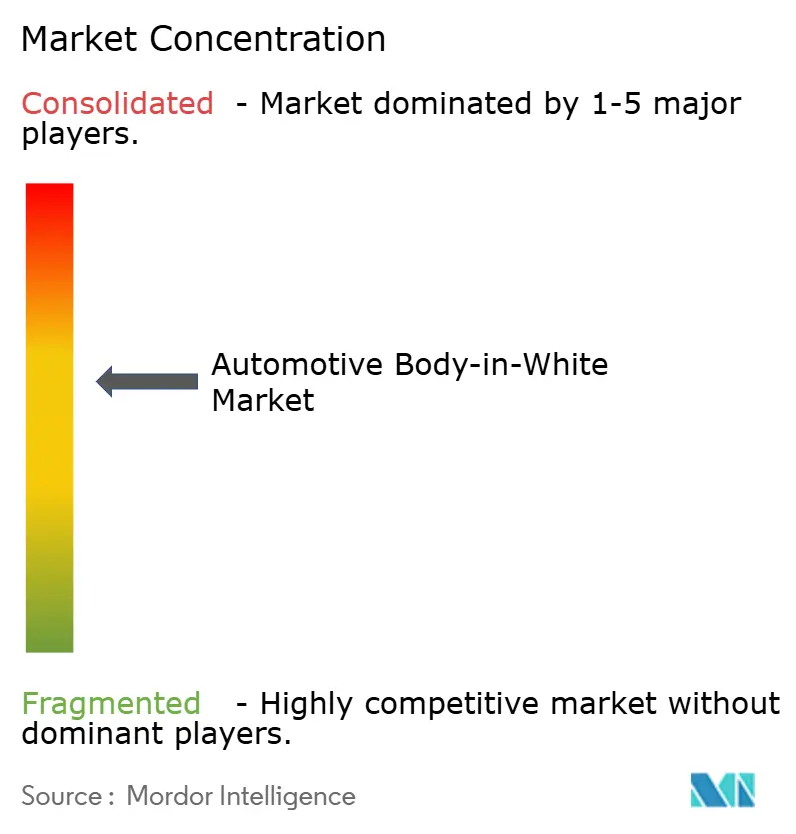
Recent Industry Developments
- September 2024: AutoForm Engineering GmbH, a frontrunner in software solutions for stamping and BiW assembly, has launched AutoForm Assembly R12. The latest version boasts enhanced capabilities, particularly in process engineering, optimization, evaluation, and hemming within the BiW assembly chain. This release introduces advanced tools designed to streamline workflows, improve accuracy, and enhance overall efficiency in BiW assembly processes, catering to the evolving needs of the industry.
- August 2024: Magna International partnered with SKH Metals Division to form SKH M, aiming to drive innovations in India's Body-in-White (BIW) and chassis systems. This partnership highlights a dedication to Industry 4.0 standards and advanced manufacturing methods. Magna spearheads engineering and product development, with BDA Partners providing advisory expertise on the transaction.
Global Automotive Body-in-White Market Report Scope
Automotive body-in-white refers to the phase in automotive manufacturing in which the sheet metal body components of an automobile have been welded together. In other words, the automotive body-in-white is the frame structure of the automobile before painting and assembly of the engine, chassis, glass, seat, doors, hood, and other such sub-assemblies.
The automotive body-in-white market is segmented by vehicle type (passenger vehicles and commercial vehicles), propulsion type (IC engine and electric vehicles), material type (aluminum, steel, composites, and other material types), material joining technique (welding, clinching, laser brazing, bonding, and other material joining techniques), and geography (North America, Europe, Asia-Pacific, and Rest of the World).
The report offers market size and forecast for the Automotive Body-in-White market in value (USD) for all the above segments.
| Passenger Cars |
| Commercial Vehicles |
| Internal Combustion Engine |
| Electric Vehicles |
| Aluminum |
| Steel (Mild, HSS, AHSS, UHSS) |
| Composites (CFRP, GFRP, SMC) |
| Magnesium and Other Metals |
| Welding (RSW, Laser, FSW) |
| Self-Piercing and Plasma-Assisted Riveting |
| Clinching and Mechanical Fastening |
| Adhesive and Hybrid Bonding |
| North America | United States |
| Canada | |
| Rest of North America | |
| South America | Brazil |
| Argentina | |
| Rest of South America | |
| Europe | Germany |
| United Kingdom | |
| France | |
| Spain | |
| Italy | |
| Rest of Europe | |
| Asia-Pacific | China |
| Japan | |
| India | |
| South Korea | |
| Rest of Asia-Pacific | |
| Middle East and Africa | Saudi Arabia |
| United Arab Emirates | |
| Turkey | |
| South Africa | |
| Rest of Middle East and Africa |
| By Vehicle Type | Passenger Cars | |
| Commercial Vehicles | ||
| By Propulsion Type | Internal Combustion Engine | |
| Electric Vehicles | ||
| By Material Type | Aluminum | |
| Steel (Mild, HSS, AHSS, UHSS) | ||
| Composites (CFRP, GFRP, SMC) | ||
| Magnesium and Other Metals | ||
| By Material Joining Technique | Welding (RSW, Laser, FSW) | |
| Self-Piercing and Plasma-Assisted Riveting | ||
| Clinching and Mechanical Fastening | ||
| Adhesive and Hybrid Bonding | ||
| Geography | North America | United States |
| Canada | ||
| Rest of North America | ||
| South America | Brazil | |
| Argentina | ||
| Rest of South America | ||
| Europe | Germany | |
| United Kingdom | ||
| France | ||
| Spain | ||
| Italy | ||
| Rest of Europe | ||
| Asia-Pacific | China | |
| Japan | ||
| India | ||
| South Korea | ||
| Rest of Asia-Pacific | ||
| Middle East and Africa | Saudi Arabia | |
| United Arab Emirates | ||
| Turkey | ||
| South Africa | ||
| Rest of Middle East and Africa | ||
Key Questions Answered in the Report
How big is the Automotive Body-in-White Market?
The Automotive Body-in-White Market size is expected to reach USD 141.92 billion in 2025 and grow at a CAGR of 3.56% to reach USD 169.05 billion by 2030.
Which region leads demand for body-in-white structures?
Asia-Pacific held 45.92% of 2024 revenue, driven by China’s EV boom and ASEAN greenfield investments.
What is the fastest-growing propulsion segment for BIW suppliers?
Electric vehicles are forecast to grow at an 11.12% CAGR, reshaping battery integration and material choices.
Which region has the biggest share in Automotive Body-in-White Market?
In 2025, the Asia-Pacific accounts for the largest market share in Automotive Body-in-White Market.
Why are adhesives gaining traction over traditional welding?
Adhesive and hybrid bonding support multi-material bodies, distribute loads evenly, and improve electrical insulation for 800 V EV platforms.
Which joining technologies are critical for giga-cast bodies?
Large aluminum castings rely on hybrid bonding, laser welding of sub-frames, and reinforced adhesive seams to handle crash loads while minimizing distortion.
